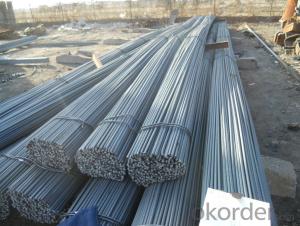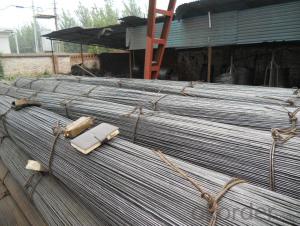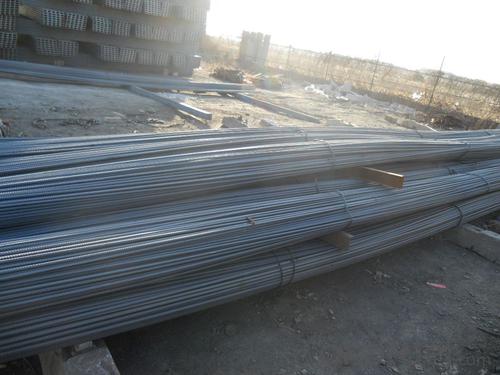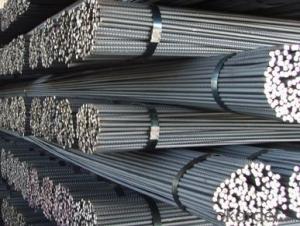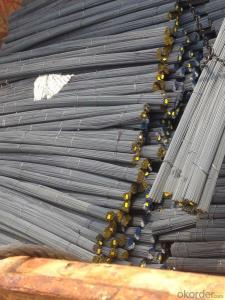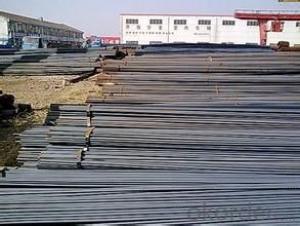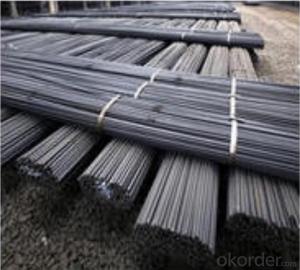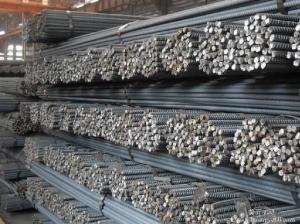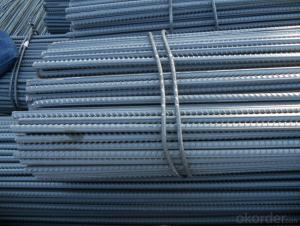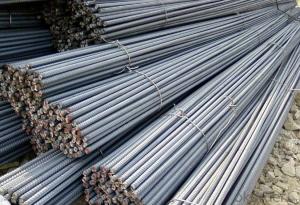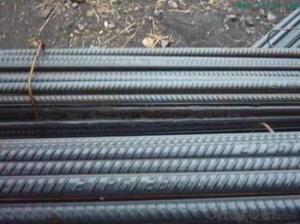Deformed steel bars type,Class IV Deformed Steel Bar with high quality
- Loading Port:
- Tianjin
- Payment Terms:
- TT or LC
- Min Order Qty:
- 50 m.t
- Supply Capability:
- 20000 m.t/month
OKorder Service Pledge
OKorder Financial Service
You Might Also Like
Product Description:
OKorder is offering Deformed steel bars type,Class IV Deformed Steel Bar with high quality at great prices with worldwide shipping. Our supplier is a world-class manufacturer of steel, with our products utilized the world over. OKorder annually supplies products to European, North American and Asian markets. We provide quotations within 24 hours of receiving an inquiry and guarantee competitive prices. We supplies a comprehensive range of standard N grade, 500 MPa deformed reinforcing bar (D500N). Length is available as your request as the reinforcing bar is often supplied processed or fabricated to suit the specific requirements of the project.
Product Applications:
Deformed steel bars type,Class IV Deformed Steel Bar with high quality are ideal for structural applications and are widely used in the construction of buildings and bridges, and the manufacturing, petrochemical, and transportation industries.
Product Advantages:
OKorder's Deformed steel bars type,Class IV Deformed Steel Bar with high quality are durable, strong, and resist corrosion.
Main Product Features:
· Premium quality
· Prompt delivery & seaworthy packing (30 days after receiving deposit)
· Corrosion resistance
· Can be recycled and reused
· Mill test certification
· Professional Service
· Competitive pricing
Product Specifications:
Manufacture: Hot rolled
Ref No. | Std Unit | Bar size mm | Length mm | Calculated metre per tonne(approx.) |
N10 | pcs | 10 | 6000 | 1582 |
N12 | pcs | 12 | 6000 | 1099 |
N16 | pcs | 16 | 6000 | 617 |
N20 | pcs | 20 | 6000 | 395 |
N24 | pcs | 24 | 6000 | 275 |
N28 | pcs | 28 | 6000 | 202 |
N32 | pcs | 32 | 6000 | 155 |
N36 | pcs | 36 | 6000 | 122 |
1 Size: From 6mm to 40mm
2 Length: 6meter, 9meter and 12meter
Package:
1: Bundle by steel strip
2: In bulk
3: Anti-water plastic woven
4: As your requirement
FAQ:
Q1: Why buy Materials & Equipment from OKorder.com?
A1: All products offered byOKorder.com are carefully selected from China's most reliable manufacturing enterprises. Through its ISO certifications, OKorder.com adheres to the highest standards and a commitment to supply chain safety and customer satisfaction.
Q2: What makes stainless steel stainless?
A2: Stainless steel must contain at least 10.5 % chromium. It is this element that reacts with the oxygen in the air to form a complex chrome-oxide surface layer that is invisible but strong enough to prevent further oxygen from "staining" (rusting) the surface. Higher levels of chromium and the addition of other alloying elements such as nickel and molybdenum enhance this surface layer and improve the corrosion resistance of the stainless material.
Q3: Can stainless steel rust?
A3: Stainless does not "rust" as you think of regular steel rusting with a red oxide on the surface that flakes off. If you see red rust it is probably due to some iron particles that have contaminated the surface of the stainless steel and it is these iron particles that are rusting. Look at the source of the rusting and see if you can remove it from the surface.
Images:
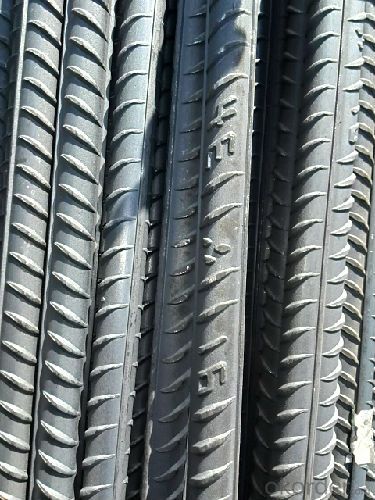
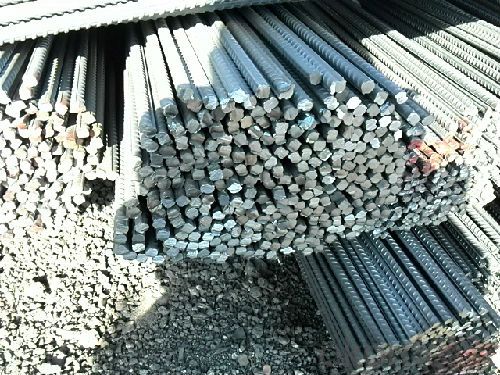
- Q: Can steel rebars be used in non-structural applications?
- Yes, steel rebars can be used in non-structural applications. They are commonly used in applications such as concrete reinforcement for sidewalks, driveways, and patios, as well as in construction projects that require additional strength and durability.
- Q: What is the process of installing steel rebars in concrete?
- The process of installing steel rebars in concrete involves several steps. First, the concrete surface is prepared by cleaning and removing any loose debris. Then, the rebars are positioned and secured using tie wires or rebar chairs to maintain the desired spacing and elevation. Next, the rebars are checked for alignment and any necessary adjustments are made. Finally, the concrete is poured, encapsulating the rebars, which provide reinforcement and strength to the structure as the concrete cures.
- Q: What is the average lifespan of steel rebars in marine environments?
- Several factors can influence the average lifespan of steel rebars in marine environments. On the whole, these rebars tend to last between 50 and 100 years in such settings. This estimate considers the corrosive properties of saltwater, which can hasten the decay of steel structures. Furthermore, the quality of the steel, the marine structure's design and construction, and maintenance practices can all impact the rebars' lifespan. Regular inspections, the application of protective coatings, and appropriate maintenance can effectively prolong the rebars' longevity in marine environments.
- Q: Can steel rebars be used in structures with high seismic activity?
- Yes, steel rebars can be used in structures with high seismic activity. Steel rebars are commonly used in seismic-resistant structures due to their high strength and ductility, which allows them to absorb and dissipate seismic energy effectively. Additionally, steel rebars can be designed and reinforced to enhance the overall seismic performance of a structure, making them a suitable choice for buildings located in regions prone to earthquakes.
- Q: Are steel rebars suitable for use in structures with aggressive soil conditions?
- Structures facing aggressive soil conditions should generally consider the suitability of steel rebars. The specific characteristics of the soil and its potential impact on the rebars must be taken into account. Aggressive soil conditions often involve excessive moisture, acidity, or corrosive substances, which can lead to corrosion and compromise the structural integrity of the construction. To prevent corrosion, several measures can be employed. One effective approach is the use of corrosion-resistant steel rebars, including stainless steel or epoxy-coated rebars. These materials offer an additional layer of protection against aggressive soil conditions. In addition, proper design and construction techniques can help minimize the adverse effects of aggressive soil conditions on the rebars. Implementing adequate drainage systems, waterproofing measures, and protective coatings can prevent direct contact between the soil and the rebars. It is crucial to seek advice from structural engineers and soil science experts when assessing the suitability of steel rebars in structures facing aggressive soil conditions. Their expertise and recommendations are invaluable for ensuring the longevity and safety of the structure.
- Q: What are the potential drawbacks of using steel rebars?
- There are a few potential drawbacks of using steel rebars. Firstly, steel rebars are susceptible to corrosion, especially in environments with high levels of moisture or chemicals. This can lead to structural degradation and reduced durability of the reinforced concrete. Additionally, steel rebars are relatively heavy, which can make construction and transportation more challenging and expensive. Moreover, steel production has significant environmental impacts, including high energy consumption and greenhouse gas emissions. Finally, steel rebars may have higher costs compared to alternative reinforcement materials, making them less economically viable in certain projects.
- Q: Can steel rebars be bent or shaped?
- Steel rebars have the capability to be bent or shaped. In construction, rebars are frequently employed to enhance concrete structures, and it is customary to bend or shape them in order to meet the project's specific design criteria. Multiple tools and techniques, including manual bending, mechanical bending machines, and hydraulic presses, can be utilized to accomplish the bending or shaping of rebars. The flexibility of steel rebars in terms of bending or shaping facilitates the creation of intricate and tailor-made reinforcement patterns, guaranteeing the concrete structure's ability to withstand the intended loads and stresses.
- Q: How do steel rebars affect the overall construction cost of industrial buildings?
- Steel rebars can significantly affect the overall construction cost of industrial buildings due to their crucial role in enhancing structural strength and durability. While the initial cost of steel rebars might be higher compared to other materials, their use can reduce the need for additional structural support, leading to potential cost savings in terms of labor, time, and materials. Moreover, steel rebars offer long-term benefits by minimizing maintenance and repair expenses, ultimately contributing to the overall cost-effectiveness of the construction project.
- Q: How do steel rebars perform in seismic zones?
- Steel rebars perform well in seismic zones due to their high tensile strength and ductility. They can withstand the intense forces and vibrations generated during earthquakes, effectively reinforcing and strengthening concrete structures. The use of rebars helps prevent structural failure and ensures the safety and stability of buildings in seismic-prone areas.
- Q: What is the recommended maximum length of cantilevered steel rebars?
- The recommended maximum length of cantilevered steel rebars depends on several factors, including the specific application, load requirements, and design codes. It is essential to consult with structural engineers and adhere to the relevant building standards and regulations to determine the appropriate maximum length for cantilevered steel rebars in a given project.
Send your message to us
Deformed steel bars type,Class IV Deformed Steel Bar with high quality
- Loading Port:
- Tianjin
- Payment Terms:
- TT or LC
- Min Order Qty:
- 50 m.t
- Supply Capability:
- 20000 m.t/month
OKorder Service Pledge
OKorder Financial Service
Similar products
Hot products
Hot Searches
Related keywords

